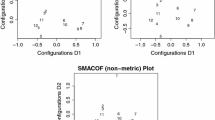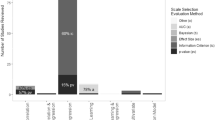Abstract
In this and a second article, we propose ‘coregionalization analysis with a drift’ (CRAD), as a method to assess the multi-scale variability of and relationships between ecological variables from a multivariate spatial data set. CRAD is carried out in two phases: (I) a deterministic component representing the large-scale pattern (called ‘drift’) and a random component modeled as a second-order stationary process are estimated for each variable separately; (II) a linear model of coregionalization is fitted to the direct and cross experimental variograms of residuals (i.e., after removing the estimated drifts) to assess relationships at smaller scales, while the estimated drifts are used to study relationships at large scale. In this article, we focus on phase I of CRAD, by addressing the questions of the choice of the drift estimation procedure, which is linked to the estimation of random components, and of the presence of a bias in the direct experimental variogram of residuals. In this phase, both the estimation of the drift and the fitting of a model to the direct experimental variogram of residuals are performed iteratively by estimated generalized least squares (EGLS). We use theoretical calculations and a Monte Carlo study to demonstrate that complex large-scale patterns, such as patchy drifts, are better captured with local drift estimation procedures using low-order polynomials within a moving window, than with global procedures. Furthermore, despite the bias in direct experimental variograms of residuals, good estimates of spatial autocovariance parameters are obtained with the double iterative EGLS procedure in the conditions of application of CRAD. An example with forest soil property and tree species diversity data is presented to discuss the choice of drift estimation procedure in practice.
Similar content being viewed by others
References
Alpargu G and Dutilleul P (2006). Stepwise regression in mixed quantitative linear models with autocorrelated errors. Commun Stat Simul Comput 35(1): 79–104
Altman NS (1990). Kernel smoothing of data with correlated error. J Am Stat Assoc 85(411): 749–759
Altman N (2000). Krige, smooth, both or neither? (with discussion). Aust NZ J Stat 42(4): 441–461
Armstrong M (1984). Problems with universal kriging. Math Geol 16(1): 101–108
Atkinson PM and Tate NJ (2000). Spatial scale problems and geostatistical solutions: a review. Prof Geogr 52(4): 607–623
Beckers F and Bogaert P (1998). Nonstationarity of the mean and unbiased variogram estimation: extension of the weighted least-squares method. Math Geol 30(2): 223–240
Berke O (2001). Modified median-polish kriging and its application to the Wolfcamp-Aquifer data. Environmetrics 12: 731–748
Bjørke JT and Nilsen S (2005). Trend extraction using average interpolation subdivision. Math Geol 37(6): 615–634
Borcard D and Legendre P (2002). All-scale spatial analysis of ecological data by means of principal coordinates of neighbour matrices. Ecol Model 152: 51–68
Borcard D, Legendre P and Drapeau P (1992). Partialling out the spatial component of ecological variation. Ecology 73: 1045–1055
Box GEP and Cox DR (1964). An analysis of transformations. J Roy Stat Soc, Ser B 26: 211–243
Chilès JP and Delfiner P (1999). Geostatistics: modeling spatial uncertainty. Wiley, New York
Cleveland WS and Devlin SJ (1988). Locally weighted regression: an approach to regression analysis by local fitting. J Am Stat Assoc 83(403): 596–610
Cressie N (1986). Kriging nonstationary data. J Am Stat Assoc 81(395): 625–634
Cressie NAC (1993). Statistics for spatial data, Revised edition. Wiley, New York
Delfiner P, Matheron G (1980) Les fonctions aléatoires intrinsèques d’ordre k. Note C-84. Centre de Géostatistique, Ecole des Mines de Paris, Fontainebleau, Paris.
Denny MW, Helmuth B, Leonard GH, Harley CDG, Hunt LJH and Nelson EK (2004). Quantifying scale in ecology: lessons from a wave-swept shore. Ecol Monogr 74(3): 513–532
Diggle PJ, Liang KY and Zeger SL (1996). Analysis of longitudinal data. Oxford University Press, Oxford
Draper NR and Smith H (1981). Applied regression analysis, 2nd edn. Wiley, New York
Fan J and Gijbels I (1995a). Data-driven bandwidth selection in local polynomial fitting: variable bandwidth and spatial adaptation. J Roy Stat Soc, Ser B 57(2): 371–394
Fan J and Gijbels I (1995b). Adaptive order polynomial fitting: bandwidth robustification and bias reduction. J Comput Graph Stat 4: 213–227
Goovaerts P (1992). Factorial kriging analysis: a useful tool for exploring the structure of multivariate spatial information. J Soil Sci 43: 597–619
Goovaerts P (1994). Study of spatial relationships between two sets of variables using multivariate geostatistics. Geoderma 62: 93–107
Goovaerts P (1997). Geostatistics for natural resources evaluation. Oxford University Press, Oxford
Hart JD and Yi S (1998). One-sided cross-validation. J Am Stat Assoc 93: 620–631
Hastie T and Loader C (1993). Local regression: automatic kernel carpentry. Stat Sci 8(2): 120–143
Helterbrand JD and Cressie N (1994). Universal cokriging under intrinsic coregionalization. Math Geol 26(2): 205–226
Hill MO (1973). Diversity and evenness: a unifying notation and its consequences. Ecology 54(2): 427–432
Høst G (1999). Kriging by local polynomials. Comput Stat Data Anal 29: 295–312
Hurvich CM, Simonoff JS and Tsai CL (1998). Smoothing parameter selection in nonparametric regression using an improved Akaike information criterion. J Roy Stat Soc, Ser B 60(2): 271–293
Jost L (2006). Entropy and diversity. Oikos 113(2): 363–375
Journel AG and Huijbregts CJ (1978). Mining geostatistics. Academic Press, London
Journel AG and Rossi ME (1989). When do we need a trend model in kriging?. Math Geol 21(7): 715–739
Keitt TH and Urban DL (2005). Scale-specific inference using wavelets. Ecology 86(9): 2497–2504
Keylock C (2005). Simpson diversity and Shannon-Wiener index as special cases of a generalized entropy. Oikos 109: 203–207
Künsch HR, Papritz A and Bassi F (1997). Generalized cross-covariances and their estimation. Math Geol 29(6): 779–799
Lark RM, Cullis BR and Welham SJ (2006). On spatial prediction of soil properties in the presence of a spatial trend: the empirical best linear unbiased predictor (E-BLUP) with REML. Eur J Soil Sci 57(6): 787–799
Larocque G, Dutilleul P, Pelletier B and Fyles JW (2006). Conditional Gaussian co-simulation of regionalized componenents of soil variation. Geoderma 134(1/2): 1–16
Larocque G, Dutilleul P, Pelletier B and Fyles JW (2007). Characterization and quantification of uncertainty in coregionalization analysis. Math Geol 39(3): 263–288
Legendre P and Legendre L (1998). Numerical ecology, 2nd English edn. Elsevier, Amsterdam
Levin SA (1992). The problem of pattern and scale in ecology. Ecology 73(6): 1943–1967
Loader C (1999). Local regression and likelihood. Springer, New York
Matheron G (1971) La théorie des variables régionalisées, et ses applications. Cahiers du Centre de Morphologie Mathématique, No 5, Ecole des Mines de Paris, Fontainebleau, Paris
Matheron G (1989). Estimating and choosing: an essay on probability in practice. Springer, Berlin
McBratney AB and Webster R (1986). Choosing functions for semi-variograms of soil properties and fitting them to sampling estimates. J Soil Sci 37: 617–639
Meisel JE and Turner MG (1998). Scale detection in real and artificial landscapes using semivariance analysis. Landscape Ecol 13: 347–362
Myers DE (1989). To be or not to be... stationary? That is the question. Math Geol 21(3): 347–362
Neuman SP and Jacobson EA (1984). Analysis of nonintrinsic spatial variability by residual kriging with application to regional groundwater levels. Math Geol 16(5): 499–521
Opsomer J, Wang Y and Yang Y (2001). Nonparametric regression with correlated errors. Stat Sci 16(2): 134–153
Pardo-Igúzquiza E and Dowd PA (1998). The second-order stationary universal kriging model revisited. Math Geol 30(4): 347–378
Pardo-Igúzquiza E and Dowd PA (2001). Variance-covariance matrix of the experimental variogram: assessing variogram uncertainty. Math Geol 33(4): 397–419
Patil GP and Taillie C (1982). Diversity as a concept and its measurement. J Am Stat Assoc 77(379): 548–561
Pelletier B, Fyles JW and Dutilleul P (1999). Tree species control and spatial structure of forest floor properties in a mixed-species stand. Ecoscience 6(1): 79–91
Pelletier B, Dutilleul P, Larocque G and Fyles JW (2004). Fitting the linear model of coregionalization by generalized least squares. Math Geol 36(3): 323–343
Platt T and Denman KL (1975). Spectral analysis in ecology. Annu Rev Ecol Syst 6: 189–210
Ripley BD (1981). Spatial statistics. Wiley, New York
Russo D and Jury WA (1987). A theoretical study of the estimation of the correlation scale in spatially variable fields. 2. Nonstationary fields. Water Resour Res 23(7): 1269–1279
Sclocco T and Di Marzio M (2004). A weighted polynomial regression method for local fitting of spatial data. Stat Methods Appl 13: 315–325
Searle SR (1971). Linear models. Wiley, New York
Shannon CE (1948). A mathematical theory of communication. AT&T Tech J 27: 379–423
Spellerberg IF and Fedor PJ (2003). A tribute to Claude Shannon (1916–2003) and a plea for more rigorous use of species richness, species diversity and the ‘Shannon-Wiener’ index. Global Ecol Biogeogr 12: 177–179
Stein ML (1999). Interpolation of spatial data: some theory for kriging. Springer-Verlag, New York
The Math Works (2006) MATLAB Version R2006, The MathWorks, Inc., Natick, USA
Tukey JW (1977). Exploratory data analysis. Addison-Wesley, Reading, USA
Turner MG, O’Neill RV, Gardner RH and Milne BT (1989). Effects of changing spatial scale on the analysis of landscape pattern. Landscape Ecol 3(3/4): 153–162
Wackernagel H (2003). Multivariate geostatistics: an introduction with applications, 3rd edn. Springer-Verlag, Berlin
Wackernagel H, Petitgas P and Touffait Y (1989). Overview of methods for coregionalization analysis. In: Armstrong, M (eds) Geostatistics, vol 1, pp 409–420. Kluwer Academic, Dordrecht
Wiens JA (1989). Spatial scaling in ecology. Funct Ecol 3: 385–397
Wu J (2004). Effects of changing scale on landscape pattern analysis: scaling relations. Landscape Ecol 19: 125–138
Zhang XF, Van Eijkeren JCH and Heemink AW (1995). On the weighted least-squares method for fitting a semivariogram model. Comput Geosci 21(4): 605–608
Zimmerman DL and Zimmerman MB (1991). A comparison of spatial semivariogram estimators and corresponding ordinary kriging predictors. Technometrics 33(1): 77–91
Author information
Authors and Affiliations
Corresponding author
Rights and permissions
About this article
Cite this article
Pelletier, B., Dutilleul, P., Larocque, G. et al. Coregionalization analysis with a drift for multi-scale assessment of spatial relationships between ecological variables 1. Estimation of drift and random components. Environ Ecol Stat 16, 439–466 (2009). https://doi.org/10.1007/s10651-008-0090-z
Received:
Revised:
Published:
Issue Date:
DOI: https://doi.org/10.1007/s10651-008-0090-z




